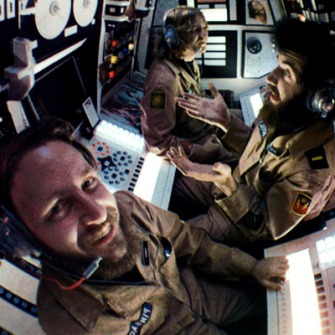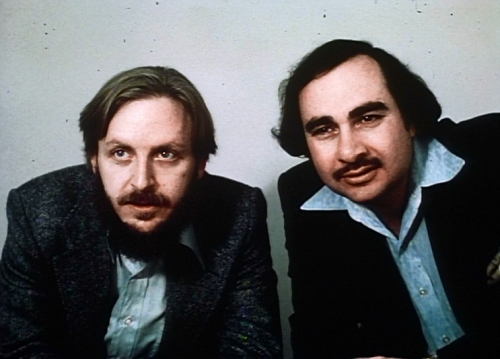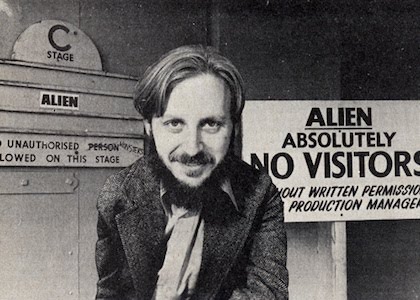This interview, conducted by Dennis Fischer, is reproduced here as printed in Monsterland Magazine’s The Aliens Story (1988) by James Van Hise.
How did Dark Star come to be?
As a University of Southern California film project in 1970. John Carpenter and I were at that time both in the film school there at SC. He approached me because he said he was going to do a science fiction film as a student project, and he asked me if I’d like to be involved in it, and I said, ‘Sure, I’d love to.’ And I got very heavily involved in it, so much so that it kind of got out of hand, really. What he originally envisioned as a 20-minute black-and-white film ended up as a 50-minute colour film, and it took just about two years to shoot it and get it done at USC. Just about the time we were finishing up editing on it, with what had been a very long and exciting and difficult road -just when we thought we were finished- we were approached by a friend of ours named Jonathan Kaplan, who subsequently produced most of John Carpenter’s movies. He was also in film school then and had a somewhat wealthy family, and he said that he would put in some additional money if we would expand it to feature length.
So then we all had to butt our heads together, and decided it meant we had to pad it. We feared we had a great student film we might end up making into a mediocre feature film by padding it and putting it onto the marketplace against professional products. But the decision finally came down to a choice between a great student film which would impress all the film schools, or a somewhat mediocre film that would be in theaters. So we opted for the feature.
I think it was the right decision because it did do more for us than it could have as a short. At that pint we launched into what amounted to another year-and-a-half of very hard work, expanding it to feature length. At the end of that time we discovered to our great disappointment that it was not as easy as we expected to sell a film in Hollywood, so we went though another fitful period of trying to find distribution. By the time the feature finally hit the theaters, four-and-a-half years had passed since the film was conceived, and that was in the spring of 1975 when Bryanston Pictures released it.
Was Star Wars the next film you worked on?
The first thing I did was turn down Dykstra’s job. That was back in ’75 when Gary Kurtz called me on the telephone and asked if I wanted to work on special effects. I had never met Kurtz. I didn’t know him or anything about him, but I certainly would have taken the job except he told me one week after I had been offered the opportunity to direct all of the special effects on Dune. I told him about that commitment, I told him about the salary and everything else, and I asked him, ‘Can you meet or better that?’ He said, ‘No, I can’t.’ So I did Dune and worked on it for six months, then it collapsed.
Then a year after the first phone call, Kurtz called me again and said, ‘Well, Star Wars is just about finished, but we still need some people to do special effects work, to do clean-up. Are you interested?’ Since that time I was absolutely flat-broke, I was very interested. So I went to work on Star Wars for a few months doing computer graphics.
Just about anywhere in the film where they cut to a screen and there’s some activity on it, some animation on it which looks computer generated, it was probably done by John Wash and Jay Teitzell under my supervision. Most of it was not done by real computers, it was simulated.
I got to work with a real computer and that was a lot of fun. Now isn’t it funny how fate works? I could have been involved to a very great extent on Star Wars except that I turned it down for another project that never went through. I did a lot of work for Star Wars; I worked pretty hard for several months. We spent a lot of money on computer graphics, and boy, when I saw the finished film, I had to admit that you could cut out everything I did out of that film and it would have still been the same film. It was so full of beautiful things that the computer graphics that we did were just .001 percent.
How did you become involved with 20th Century Fox’s Alien?
When Dune fell through, I ended up back in L.A. flat broke, without an apartment, without a car, with all my belongings in storage. I didn’t know what to do. I moved in on a friend’s sofa. His name is Ronny Shusett, and he had also had a string of very bad breaks. We decided to do something together.
I was more desperate than he was because I had to get off of his sofa, so we wrote a script called Alien. That script, from the moment I typed ‘The End’ proceeded to take on a life of its own. Everybody in town wanted it, We just couldn’t believe it. Everything had fallen through for us. Nothing had ever worked. It had always gone so badly we said, ‘Well, yeah, they’re all yelling about it, and they all want it, but it ain’t gonna work ’cause it never does. It’s just a lot of baloney.’
It just kept going and going and we made a deal with Brandywine Productions, and made a deal with 20th Century Fox, and they started pouring money into it, hiring people, and we kept saying, ‘Nah, it ain’t gonna happen.’ Then we got cheques -they paid us cheques- and we looked at each other and said, ‘It’s happening.’ Step by step we kept saying, ‘Nah, it will fall through by the next step, they always do,’ but it never did. It just kept expanding and expanding and growing.
We sat down on a few occasions, Ronny and I, and we said, ‘Let’s see why this went so well and everything else went so badly when this isn’t even our favourite script.’ We said, ‘Well, we caught this science fiction boom just right… our script was on the market just a month after Star Wars was released,’ and we looked at other reasons like that. But when it came right down to it, we could never explain why that script went out so far so fast by comparison with so many other things we have done. It’s a mystery – one of this things that happen in life.
By accident, by itself, by mysterious forces of God, it happened.
Because Alien is a Gothic, which the film industry understands?
You have to understand that after Dark Star, when that film was completed, when I saw the film up there on the screen as compared to what I had intended to make. Then I saw the reactions of the industry and the public to that film. It burned certain lessons into my head like a branding iron. Just right into my brain.
One lesson was not to make an episodic film; have a tight plot. Another lesson was do not make a comedy because nobody laughed. When I sat down to write Alien, Alien was very similar to Dark Star in many ways. It was just, ‘Well, I can’t make them laugh, maybe I can make them scream.’ Obviously, it worked. Applying those lessons did produce something that appealed more directly to people. I mean, there are reasons, right? There are all kinds of individual little reasons. Yeah, it’s a fine script, that’s another reason, right? But then the world is an injustice and we’ve written fine scripts that were better and more commercial and just didn’t go anywhere.
This was a good script. It caught the science fiction market, and it was a combination of science fiction and horror, and nobody else had it out at that time. We figured those were the reasons. But then in that case, why didn’t script X, Y and Z do just as well? It just happened. It was luck.
You also acquired a fine group of actors including Tom Skerritt.
It was fun talking with those guys because the thing I’ve been working towards all these years is being a director. I’ve had practice at all of the things a director does except working with actors. I’ve done all the special effects. I’ve rolled the film through the camera. I’ve edited. I’ve lit sets. You know, everything. You might say my muscle is well-exercised in all aspects of the film except that of directing actors because I haven’t been allowed to get near them for years. There was always someone else directing. To counteract that, I’ve tried to spend all my time talking to actors and watching the directing working with them.
This was a wonderful opportunity to have Tom Skerritt, Yaphet Kotto, Harry Dean Stanton and John Hurt -a lot of excellent people- in there.I hung around as much as possible and talked as much as I could get away with, and watched them being directed.
I’ll never forget one incident. One thing I’ve always been concerned about is the general belief in town -I think that Hitchcock stated it- that actors are idiots. They are impossible to work with. Generally they are the one thing that everyone wishes they could do without on a movie. I remember I was called in just before they were getting ready to shoot because the actors were busy reading through a scene. They called me in because they had objections about the dialogue. I went in, and they said, ‘Aw, I can’t say this line,’ or ‘I can’t say that line.’ I sat down with them with a script and all the different actors pointed out all the different lines they had trouble with and what they thought should be done about it. And I agreed with every last thing they said. I thought these people are not fools, they are right. It was a very good experience to be able to see those guys work.
Did they film your original script without too many changes?
Well, David Giler, who is one of the producers, sat down and just kept rewriting it all. Just kept rewriting and rewriting it, and rewriting it, until there was very little resemblance to the original screenplay. I wasn’t allowed to participate in that because he didn’t want me to. He was producer.
Then two weeks before we started shooting, he left for mysterious reasons. He left the production. The main producer, Gordon Carroll, and the director called me in and there were two week of frantic mutual work between all of us trying to put the script into shape. By the time we got done, it was maybe 80 percent of what the original draft was. What we got on the screen was actually very close to the original draft.
What connection did you have with the design of the film?
Originally, I sat down before they had a director, and they said, ‘Design the film.’ So I hired Ron Cobb immediately and I asked him to bring Chris Foss from London. To my surprise, they did. They brought him over here. And I asked him to get H.R. Giger from Switzerland, and so they had Cobb and Foss over here and they designed a tremendous amount of the picture. Fox didn’t want to hire Giger, which was the hardest fight.
Originally, there were three cultures -the Earth culture and two alien cultures- and along the way one of the two alien cultures had been completely eliminated from the script. It was too much of a committee movie. Everybody was involved in the making of this. Evry last executive in Fox; every last person had two cents in. So we have these two cultures now, just two.
[Ron Cobb] did a lot. He designed practically all of the hardware. They used him the way you would use a dirty old wrench. Whenever they couldn’t figure out how to design something, they said, ‘Here Cobb, you design it.’ Since they could not figure out how to design most of the things in the movie, he ended up designing most of the things. Yet he was never regarded as being in charge of that.





The interview just stops like that in the magazine?
I was really enjoying that and then it just stops.
Pingback: Crew Logs: Dan O’Bannon | Strange Shapes
Pingback: The making of Alien: Dark Star – Silent Frames